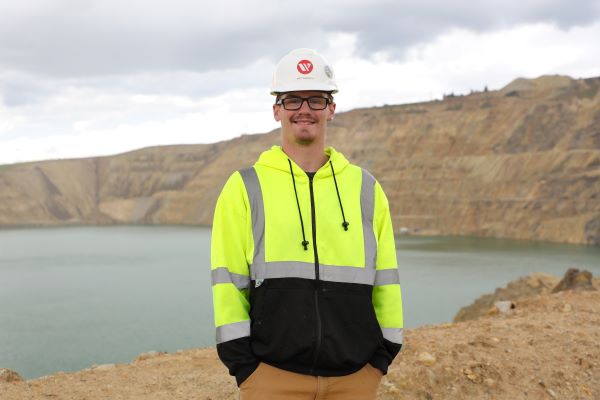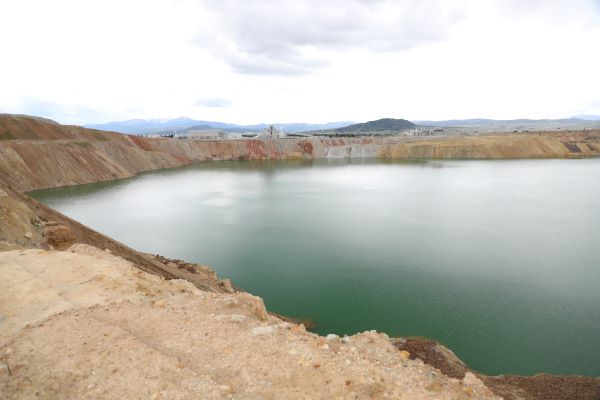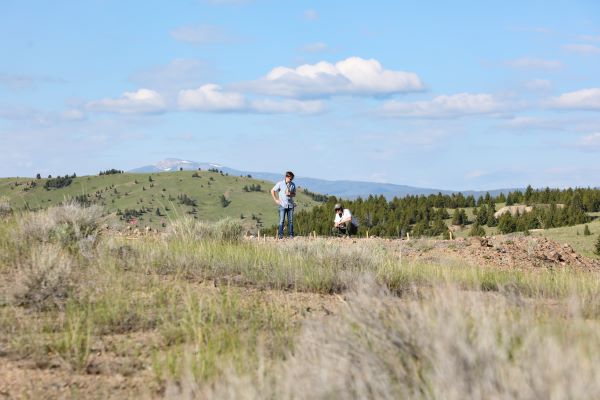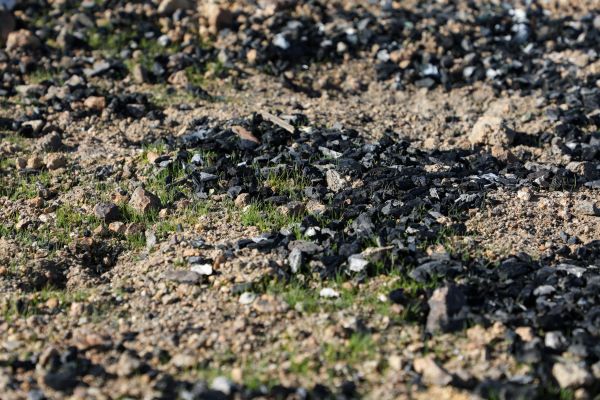CENTER FOR ENVIRONMENTAL REMEDIATION AND ASSESSMENT EXPLORES CREATIVE SOLUTIONS
TO ENVIRONMENTAL ISSUES

As he grew up in Butte, Matthew Ingersoll (B.S. Environmental Engineering ’23) knew that the Berkeley Pit was often seen as an irredeemable environmental issue.
“My whole life I’ve always heard that there’s not really anything we could do about the Berkeley Pit, and that it would be a problem forever,” Ingersoll remembered.
Researchers and students at Montana Tech’s Center for Environmental Remediation and Assessment (CERA) are attempting to take “forever problems” like the Berkeley Pit contamination and reimagine solutions with community partners that aren’t just beneficial for the environment, but have the potential to breathe economic life back into areas that were once bastions of industry. CERA is a multidisciplinary cross-college collaboration that intertwines work with numerous academic departments, agencies, and research groups, extending solution-based thinking beyond traditional disciplinary lines. CERA was revitalized in 2022, after initially being established in 2000.
The Berkeley Pit was formed when dewatering pumps were turned off at the Kelley Mine in 1982. Groundwater began to fill more than a century’s worth of underground mine workings that span more than 10,000 miles. The rock in the underground workings leached out toxic metals into the water, which collected in the Berkeley Pit. Today it’s estimated that the pit holds approximately 50 billion gallons of impacted water.
But in September 2019, site managers flipped the pumps on for a new system. This one involves cleaning the water from the Berkeley Pit, and discharging within established EPA standards into Silver Bow Creek. Through August 2023, over 7.9 billion gallons of this treated water has been released. In addition, the level of water in the Berkeley Pit has been maintained, instead of inching higher and threatening the groundwater aquifer.

In his dual role as a Montana Resources Environmental Engineering intern and Montana Tech graduate student, Ingersoll is working with faculty in Metallurgical, Environmental, and Mechanical Engineering to recover critical minerals from the Berkeley Pit water.
“It feels really cool to be able to feel like we’re at least getting some sort of additional benefit out of the Berkeley Pit,” Ingersoll said. “It’s not fixing the problem necessarily, but it is cleaning the water a little
bit more.”
Federal officials have said the development of domestic supply chains for critical minerals and rare earth elements is paramount to national security, and there’s a lot of interest in the Berkeley Pit because samples have shown concentrations of critical minerals and rare earth elements to be significant.
Ingersoll’s project is just one of many CERA has undertaken since it was relaunched in 2022. If you travel down an old dirt mining road west of campus, you’ll find some other projects underway in the proposed Energy and Environment Innovation Field Campus Area.
The land here is uneven and only accessible via a sandy, rutted primitive road—but Tech has big plans to make a place where students and faculty can work to test their research on a larger scale. There are large mounds of mine waste and rock that have been untouched for decades. Plants have gained a foothold in some areas, but in many places the ground is hard and orangish-yellow.
“There’s quite a bit of mine waste, particularly on this hillside, and not a lot of plants,” Earth Sciences and Engineering PhD student Paul Helfrich noted as he gave a tour of a remediation project area in June. “We’ve got all sorts of recreational use back here, and that has really allowed some of our invasive species of plants to take
hold here.”

Knapweed, crested wheatgrass, and a couple of other invasive species have moved into the area. The seeds were likely inadvertently brought in and have taken hold because of a combination of recent recreational activity in the area and historic disturbances related to mining.

"The biggest problem with this area is the metals, the soil compaction, and lack of water we see
in the soil,” Helfrich said. “The soil health is really poor right now. When you don’t have a lot of organic material and you have a lot of erosion, you get an inability of the soil to hold water. We need to figure out a way to successfully keep the water here, instead of it running right off.”
Helfrich, Chris Austin, and Keenan Cassidy used agricultural equipment to till up small plots of the area.
“We planted each plot with three different native species,” Helfrich said. “We selected some grass types that we thought would be good fits.”
In addition to seeds of prairie junegrass, bluebunch wheatgrass, and Idaho fescue, the plots also include varying portions of biochar from Dr. Rick LaDouceur’s laboratories added to the plots. Biochar resembles charcoal, and is the substance that is left over after biomass has been burned. It is often used as a soil amendment.
Ten days into the experiment, the native seeds had sprouted. The bluebunch wheatgrass was the first to appear and grew much more quickly than the other species.
The control group, which had no biochar amendments and only had till done, had many sprouts as well, which surprised the group.
“I think this really speaks to the problem of compaction in these historic mine waste sites,” Helfrich said. “A lot of times when they get wet, it becomes very stuck together, which makes it difficult for
plant roots to pierce the soil.”
Though the grass is growing, the team is also monitoring other biological indicators of successful restoration. Pit traps surround the plots so team members can taxonomize insects in the area. The traps are emptied and inventoried weekly.
“We are trying to see if we can stimulate an ecological response through our biochar plots,” Helfrich said. “The jury is still out on that at the moment.”
The experiment will run until snow flies, but the team will check to see if sprouts pop back up in the spring. In the future, students want to try different agricultural grasses to study those species as well.
Student Emma Harrison is working to remediate the runoff coming off the site. She plans to design, build, and install containers of biochar and activated carbon that are sculpted from porous clays to look like natural rocks. The idea is that the carbon will act as a filter and absorber, pull mining waste metals from the runoff.
Additional projects planned for the area include a demonstration solar project that Tech Senior Design students and students from Highlands College will design and construct this fall. The solar display will be built like a headframe, and will be paired with picnic tables and outlets to charge electronic devices like cellphones or
laptops while people enjoy outdoor recreational space. The solar demo is being used for research as Montana Tech, Butte–Silver Bow, and Montana Resources explore opportunities to create solar energy developments on operating and abandoned mine lands.
CERA is also coordinating with Kansas State University on a 3-year grant that will provide technical assistance to Brownfields projects in Butte and Anaconda. The EPA estimates that there are more than 450,000 Brownfields in the U.S. These are places contaminated by hazardous substances, pollutants, or contaminants. The
Environmental Defense Fund notes there are more than 250 of these sites in Montana.
An initial team from Montana Tech’s Industrial Health and Environmental Engineering departments and the Clark Fork Watershed Education Program will work with Kansas State University and additional KSU-affiliated organizations to use Butte and Anaconda communities to aid stakeholders in understanding complex Brownfields-related issues by providing specialized knowledge and guiding communities through the assessment, cleanup, and revitalization process.
“This collaborative effort is an exciting opportunity to formalize Montana Tech’s efforts to share its expertise in environmental engineering and management with impacted communities,” Vice Chancellor for Research Dr. Angela Lueking said. “The grant provides resources and incentives for Tech faculty and staff to engage in community education and outreach, including ways to assess relevance of new and emerging remediation technologies. We appreciate the opportunity to collaborate with Kansas State and work with the EPA’s Technical Assistance to Brownfields program, as this program embodies the applied learning and technology translation that differentiates Montana Tech’s educational mission.”
The relationships and progress CERA has made since its revival a year ago are blazing a trail to provide students hands-on opportunities to test their knowledge and conduct research to improve the environment, while maintaining a focus on using nature for energy and environmental solutions, economic viability of their ideas, community/social engagement, and integration and innovative research.
To learn more or collaborate, visit mtech.edu/cera/